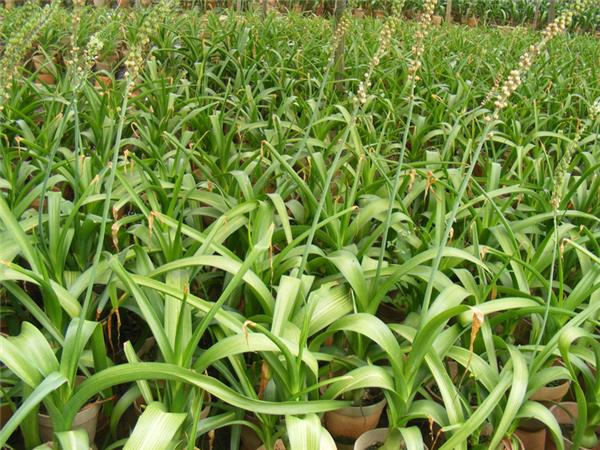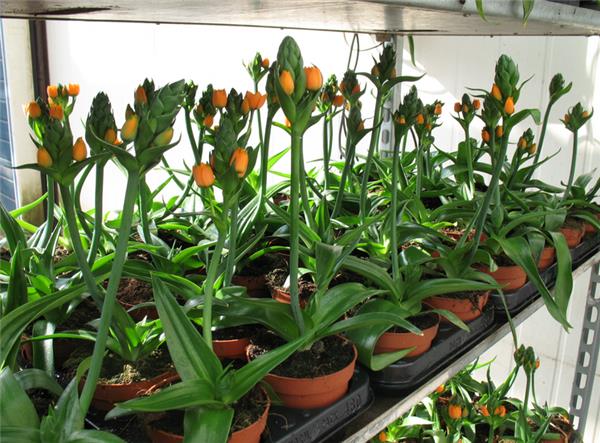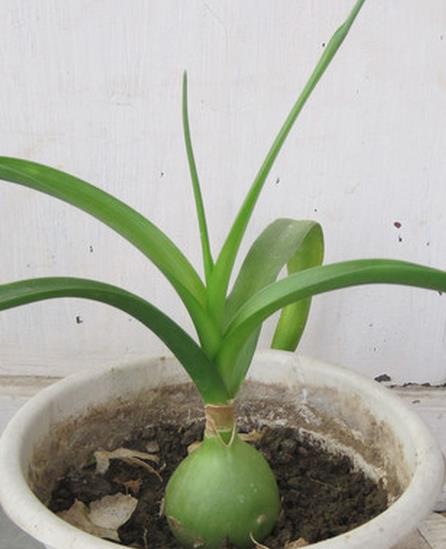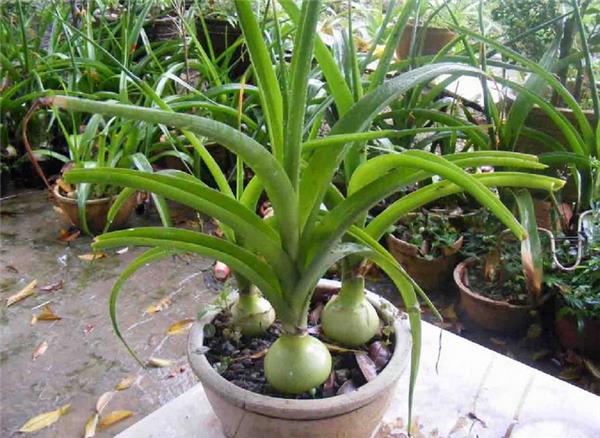The introduction and breeding methods of Tiger Eye evergreen let you grow the green plant of tiger and tiger.
Tiger-eye evergreen, alias sea onion, because of the shape of tiger eyes, so named Tiger-eye evergreen. Also because of its bulbous bulb like gourd, so also commonly known as gourd orchid. Let's take a look at the knowledge of tiger-eyed evergreen.

1. Ecological Habits of Tiger-eye Evergreen
Tiger-eye evergreen is native to southern africa. Sunny, but also resistant to semi-shade, cold, summer direct sunlight, good humid environment, winter heavy frost after the leaf clusters are still green. Like deep, humus-rich, loose, well-drained soil and semi-cloudy summer, winter light sufficient environment. Not cold, winter greenhouse needs to be above 8℃. Bulbs have summer dormancy habit, strong differentiation and high propagation coefficient.

2. Cultivation techniques of Ornithalia tiger-eyed
1. Transplanting in pot
When the seedlings are potted, first put 2~2 cm thick coarse grain matrix or ceramsite into the bottom of the pot as a filter layer, sprinkle a layer of fully decomposed organic fertilizer as a base fertilizer, the thickness is about 1~2 cm, and then cover a layer of matrix, the thickness is about 1~2 cm, and then put in the plants to separate the fertilizer from the roots to avoid burning the roots.
The substrate for the upper pot can be selected from the following one: peat + pearlite + ceramsite =2 parts +2 parts +1 part; peat + slag + ceramsite =2 parts +2 parts +1 part; sawdust + vermiculite + medium coarse river sand =2 parts +2 parts +1 part. After finishing the basin, pour a permeable water, and put it in a slightly shady environment for a week.
When transplanting seedlings, dig planting holes first, sprinkle a layer of organic fertilizer at the bottom of planting holes as base fertilizer (base fertilizer), the thickness is about 4~6 cm, then cover a layer of soil and put seedlings in order to separate fertilizer from roots and avoid burning roots. After putting in seedlings, backfill soil, cover roots, step on soil with feet, and irrigate once.
2. humidity management
Likes the drier air environment, the cloudy and rainy day is too long, is susceptible to the germ infection. Avoid rain and keep leaves dry at night.

3. temperature management
Like cold weather, afraid of extreme heat, summer difficulties; not resistant to frost, when the temperature drops below 10℃ will enter dormancy. The optimum growth temperature is 15~28℃.
4. light management
In late autumn, winter, early spring three seasons, because the temperature is not very high, it is necessary to give it direct sunlight irradiation, in order to facilitate its photosynthesis and the formation of flower buds, flowering, fruit. If you encounter hot weather or in summer, you need to block about 50% of the sun. After flowering, put it indoors for maintenance and viewing, and put it near the southeast doors and windows to prolong the flowering period and increase the number of flowers as much as possible.
5. fertilizer and water management
The fertilizer (water) principle of "light fertilizer, frequent application, small amount and complete nutrition" is required to be followed: the spring and autumn seasons are the peak seasons for its growth, and the fertilizer and water management is in the order of "flower treasure"-"flower treasure"-"clear water"-"flower treasure"-"flower treasure"-"clear water (At least twice a week to ensure "flower treasure"), the interval period is about: outdoor maintenance of 1~4 days; indoor maintenance of 2~6 days; sunny or high temperature interval period shorter, rainy days or low temperature interval period longer or not watering.
Summer is the season of slow growth, so we should control fertilizer and water properly. Fertilizer and water management according to the "flower treasure"--clear water--"flower treasure"--clear water--clear water cycle, interval cycle through spring and autumn. Water plants in the morning or evening when temperatures are low and spray them frequently. Watering time should be arranged as far as possible in the morning when the temperature is lower.
During winter dormancy period, fertilizer and water control are mainly carried out. Fertilizer and water management shall be circulated in the order of "flower treasure"-clear water-"flower treasure"-clear water-clear water. The interval period is about 7~10 days. The interval period between sunny day and high temperature period is shorter, and the interval period between rainy day and low temperature period is longer or no watering. Watering time should be arranged as much as possible in sunny days when the temperature is higher at noon.

6. modeling trim
The dwarf tiger-eyed evergreen flower of flower climbing can reach flying rice, the top raceme florets as many as dozens of flowers, heavy gravity, plus the slender flower climbing, easy to form top-heavy, lodging phenomenon, affecting viewing. Dwarfing methods include:
① Carving flowers and plants for many times: After the flower bud appears, scrape the epidermis to the upper end of the bulb with a knife, so that it bends to the side of the wound, and then cut the epidermis in the opposite direction below the wound after a few days, so that it bends to the new wound, forming an S-shaped bend. After shaping, scrape one side of the last cut for the third time, so that it bends to the third cut, and then cut below the latest cut to bend it. After repeated scraping, flowers and plants continue to bend back and forth, so the plant dwarfs.
② One-time scraping: When the flowers and plants are as high as 40 cm or so, scrape the flowers at one time according to the above method. The wound can be longer, but it must be fixed with iron wire or plastic tape. Remove it after the wound has healed and fixed.
The above is tiger-eyed evergreen knowledge, I hope to give you help.
Bend it toward the third cut, then bend it under the latest cut. After repeated scraping, flowers and plants continue to bend back and forth, so the plant dwarfs.
② One-time scraping: When the flowers and plants are as high as 40 cm or so, scrape the flowers at one time according to the above method. The wound can be longer, but it must be fixed with iron wire or plastic tape. Remove it after the wound has healed and fixed.
The above is tiger-eyed evergreen knowledge, I hope to give you help.
- Prev

Good things come in pairs and good flowers come in pairs to tell you about the introduction and breeding methods of orchids.
Good things come in pairs and good flowers come in pairs to tell you about the introduction and breeding methods of orchids.
- Next

Introduction and culture methods of ivy, a foreign plant from Europe
Introduction and culture methods of ivy, a foreign plant from Europe
Related
- Wuhan Hospital Iron Tree Blooming Result Was Instantly Frightened by the Gardener Master
- Which variety of camellia is the most fragrant and best? Which one do you like best?
- What is the small blue coat, the breeding methods and matters needing attention of the succulent plant
- Dormancy time and maintenance management of succulent plants during dormancy
- Minas succulent how to raise, Minas succulent plant pictures
- What are the varieties of winter succulent plants
- How to raise succulent plants in twelve rolls? let's take a look at some experience of breeding twelve rolls.
- Attention should be paid to water control for succulent plants during dormant period (winter and summer)
- Watering experience of twelve rolls of succulent plants
- Techniques for fertilizing succulent plants. An article will let you know how to fertilize succulent plants.

